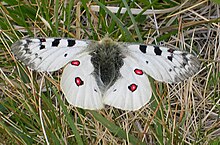
The Pieridae are a large family of butterflies with about 76 genera containing about 1,100 species, mostly from tropical Africa and tropical Asia with some varieties in the more northern regions of North America and Eurasia. Most pierid butterflies are white, yellow, or orange in coloration, often with black spots. The pigments that give the distinct coloring to these butterflies are derived from waste products in the body and are a characteristic of this family. The family was created by William John Swainson in 1820.

Swallowtail butterflies are large, colorful butterflies in the family Papilionidae, and include over 550 species. Though the majority are tropical, members of the family inhabit every continent except Antarctica. The family includes the largest butterflies in the world, the birdwing butterflies of the genus Ornithoptera.

The osmeterium is a defensive organ found in all papilionid larvae, in all stages. The organ is situated in the prothoracic segment and can be everted when the larva feels threatened. The everted organ resembles a fleshy forked tongue, and this along with the large eye-like spots on the body might be used to startle birds and small reptiles. The osmeterial organ remains inside the body in the thoracic region in an inverted position and is everted when the larva is disturbed in any way emitting a foul, disagreeable odor which serves to repel ants, small spiders and mantids. To humans, this odour is rather strong but pleasant, usually smelling like a concentrated scent of the caterpillar’s food plant and pineapple.

Parnassius maharaja, the maharaja Apollo, is a high-altitude butterfly which is found in India and west China. It is a member of the snow Apollo genus (Parnassius) of the swallowtail family (Papilionidae).

Parnassius delphius, the banded Apollo, is a high-altitude butterfly which is found in Central Asia. It is a member of the genus Parnassius of the swallowtail family, Papilionidae.

Parnassius acco, the varnished Apollo, is a high-altitude butterfly found in Asia. It is a member of the snow Apollo genus Parnassius of the swallowtail family, Papilionidae.

Parnassius hannyngtoni, the Hannyngton's Apollo, is a high-altitude butterfly which is found in India. It is a member of the snow Apollo genus (Parnassius) of the swallowtail family (Papilionidae). Some sources also spell the name as P. hunnygtoni. It is named after Frank Hannyngton who obtained the specimen from the Chumbi Valley.

Parnassius actius, also known as the scarce red apollo, is a high-altitude butterfly found in Central Asia. It is a member of the snow Apollo genus (Parnassius) of the swallowtail family (Papilionidae).

Parnassius tianschanicus, the large keeled Apollo, is a high-altitude butterfly. It is a member of the snow Apollo genus (Parnassius) of the swallowtail family, Papilionidae.

Parnassius is a genus of northern circumpolar and montane butterflies usually known as Apollos or snow Apollos. They can vary in colour and form significantly based on their altitude. They also show an adaptation to high altitudes called altitudinal melanism. They show dark bodies and darkened colouration at the wingbase which helps them warm faster using the sun.

Parnassius glacialis, the glacial Apollo or Japanese clouded Apollo, is a high-altitude butterfly found in Japan, eastern China and Korea. It is a member of the snow Apollo genus (Parnassius) of the swallowtail family (Papilionidae).

Parnassius clodius is a white butterfly which is found in the United States and Canada. It is a member of the snow Apollo genus (Parnassius) of the swallowtail family (Papilionidae). Its elevation range is 0–7,000 ft (0–2,134 m).

Parnassius eversmanni, or Eversmann's parnassian, is a high-altitude butterfly which is found in eastern Russia, Mongolia, Japan, Alaska, and the Yukon. It is a member of the snow Apollo genus (Parnassius) of the swallowtail family, Papilionidae. The species was named to honour Eduard Friedrich Eversmann.

The Japanese luehdorfia is a species of butterfly in the subfamily Parnassiinae of Papilionidae. It is found only in Japan. It was discovered by Yasushi Nawa in Japan's Gifu Prefecture in 1883. It is also known as the Gifu butterfly

Parnassius boedromius is a high-altitude butterfly found in Asia. It has a restricted range, known only along the borders of Kyrgyzstan, Kazakhstan and Xinjiang, China. Formerly a subspecies of Parnassius simo. It is a member of the snow Apollo genus (Parnassius) of the swallowtail family (Papilionidae).

Parnassius szechenyii is a high-altitude butterfly which is found in western China. It is a member of the snow Apollo genus (Parnassius) of the swallowtail family, Papilionidae. The species was first described by Imre Frivaldszky in 1886.

Allancastria is a genus of Palaearctic swallowtail butterflies in the subfamily Parnassiinae. Five species are known. The genus has a complex history.

Parnassius cardinal, the cardinal Apollo, is a high-altitude butterfly which is found in north Afghanistan and Tajikistan. It is a member of the snow Apollo genus (Parnassius) of the swallowtail family (Papilionidae). The species was first described by Grigory Grum-Grshimailo in 1887.
Parnassius nandadevinensis is a high-altitude butterfly which is found only on Mt Nanda Devi, India. It is a member of the snow Apollo genus (Parnassius) of the swallowtail family (Papilionidae). It was described on the basis of a single worn specimen. The genitalia are said to be intermediate in structure between P. acdestis and P. stoliczkanus and could possibly represent an aberrant specimen of either.


























